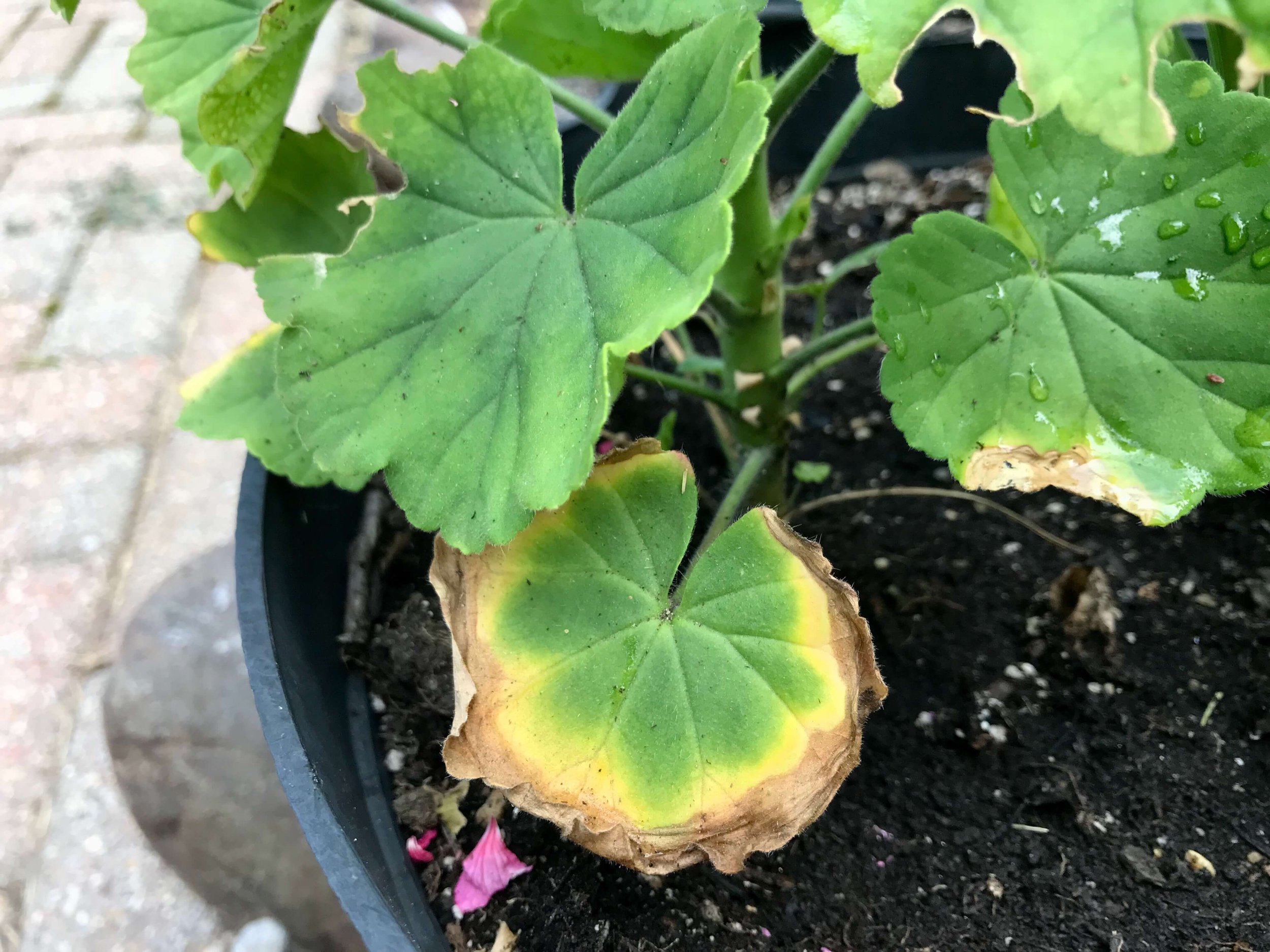Geraniums, which are hardy and are also called cranesbills, look great in beds and borders. The best varieties bloom for months with pretty, colorful flowers, but if the leaves turn yellow, something is wrong.
As long as you know how to grow and take care of hardy geraniums, they should be a breeze to add to your garden.
But leaves that turn yellow can be a problem. We asked gardening experts to explain what causes this and what you can do to fix it.
Geraniums are popular flowering plants that add vibrant color to gardens, patios, and containers. However, yellow, discolored leaves can ruin their ornamental appeal.
Several issues cause geranium foliage to turn yellow. By identifying the cause and taking appropriate action, you can restore the leaves to their normal green hue.
6 Common Reasons for Yellow Geranium Leaves
Here are the most frequent reasons geranium leaves turn yellow and what you can do about it:
1. Overwatering
One of the most common causes of yellowing leaves is too much moisture or overwatering Generally, on overwatered plants, the bottom portions of geraniums have yellow leaves. They may also develop pale looking water spots
If this is the case you should immediately stop watering and allow the plants to dry out. Check the soil moisture before watering again and only water when the top 1-2 inches become dry. Improve drainage by amending soil with compost or planting in containers with holes.
2. Underwatering
While less likely, inadequate water can also cause yellowing, usually starting on leaf tips and edges first. Apply a thorough, deep watering when the top of the soil becomes dry. For container plants, check soil moisture daily and don’t let pots completely dry out.
3. Insufficient Light
Geraniums thrive in full sun and need at least 4-6 hours of direct sunlight daily for lush growth. Too much shade causes lower leaves to turn yellow from lack of chlorophyll. Move plants to the sunniest spot possible or trim back surrounding plants blocking sunlight.
4. Cold Weather or Frost
If yellow leaves coincide with cooler temperatures or frost, this is generally normal. Allow any damaged foliage to die back. The plant will produce fresh new leaves in spring. Provide extra mulch around the base to protect roots from hard freezes.
5. Nutrient Deficiencies
Yellow leaves often indicate a lack of nutrients, particularly nitrogen which is needed for chlorophyll production. Fertilize plants with a balanced fertilizer or compost to supply nitrogen, phosphorus, and potassium. Address micronutrient shortages like iron or magnesium.
6. Diseases or Pests
Serious fungal diseases like botrytis blight can cause yellowing. Look for other signs like wilting, spots, webbing or insects. Remove and destroy affected plants. Control pests like aphids that suck juices from leaves. Apply horticultural oils or insecticidal soap sprays.
Caring for Geraniums to Prevent Yellow Leaves
Prevent yellow leaves by providing proper care:
- Plant in well-draining soil amended with compost
- Water only when the top 1-2 inches of soil are dry
- Grow in full sun, with at least 4-6 hours of direct light
- Feed every 6-8 weeks with a balanced fertilizer
- Prune back spent flower stems to encourage new growth
- Remove fallen leaves and debris to prevent disease
- Bring potted geraniums indoors before first fall frost
Natural Cures for Yellow Leaves on Geraniums
If discolored leaves are due to nutrient deficiencies, try these organic solutions:
-
Work 1-2 inches of compost into the soil around plants to supply a broad spectrum of nutrients.
-
Mix 1 tablespoon Epsom salts (magnesium sulfate) per gallon of water and apply around the plant.
-
Spray leaves with a mixture of 1 tablespoon apple cider vinegar per quart of water.
-
Brew compost or comfrey tea and use to water plants once per month.
-
Mix a diluted fish emulsion fertilizer according to package directions.
-
Crush aspirin (which contains salicylic acid) into a powder and sprinkle around the plant.
Improving growing conditions and fertilizing with organic nutrients often helps restore yellow leaves to health. But if discoloration persists or worsens, the issue may be a disease requiring further treatment.
When to Worry About Yellow Geranium Foliage
While occasional yellow leaves are normal, significant yellowing or entire yellow plants is cause for concern. This can indicate:
- Soggy, waterlogged soil leading to root rot
- An infestation of spider mites, aphids, or other pests
- Development of a fungal infection
- Presence of a bacterial disease
If yellowing worsens despite your best efforts, the geranium likely requires treatment beyond good care. Insect infestations may need a pesticide, while bacterial or fungal diseases require specific antibiotics or fungicides.
With attention to proper planting, care, and prompt treatment of any problems, you can continue to enjoy gorgeous geraniums all season long without yellow leaves spoiling their beauty.
5 reasons why geranium leaves turn yellow
Growing geraniums in flowerbeds, borders, and containers has many benefits. One of these is that you can find flowers that are hardy enough to grow in your soil and conditions. But if plants that were thriving develop yellow leaves, something’s amiss and these are the possibilities. ( credit: Martin Hughes-Jones / Alamy).
First, the first reason geranium leaves can turn yellow is more common in pelargoniums than in hardy geraniums. It’s important to know which type of geranium you’re growing, though, since both are called geranium.
‘It is quite common for the lower leaves on plants to turn yellow and fall off,’ explains Amateur Gardening expert Steve Bradley. ‘Most plants will shed older leaves that are no longer contributing to the growth and wellbeing. This happens more rapidly if the leaves concerned are fully or partially shaded.’
As for yellow leaves on hardy geraniums, this can be a result of the issues that follow.

Steve has written or co-written more than 40 useful gardening books. He was asked to update some of the best-selling gardening books in the world, the Expert series, which were first written by Dr. David Hessayon.
Over the years, Steve has also written for most of the popular UK gardening magazines, including Amateur Gardening. He is a member of The Garden Media Guild and has a vast knowledge of gardening and enjoys sharing it with listeners to BBC local radio in the UK. He is a resident gardening expert, answering listeners’ questions during live gardening phone-in shows.
Want of nutrients
Yellow geranium leaves can be a sign that they need to be fertilized. ‘When geranium leaves turn yellow, it is often a sign of a nutrient deficiency,’ says Susan Brandt. “Plants need a balance of essential nutrients to grow well, and any imbalance can show up as yellowing leaves or other visible signs.”
‘One common cause of yellowing leaves in geraniums is a lack of nitrogen. Nitrogen is an essential nutrient that promotes healthy leaf growth and overall plant vigor. When there is a deficiency of nitrogen, the leaves may turn yellow from the bottom up.
‘Another potential cause of yellowing leaves in geraniums is a lack of iron or magnesium. Lack of magnesium can make leaves turn yellow all over, and lack of iron can cause interveinal chlorosis, which is yellowing between the veins.
“To fix this lack of nutrients and get geraniums’ leaves back to being healthy, it is important to fertilize them with the right nutrients.” A balanced fertilizer containing nitrogen, iron, and magnesium can help address these deficiencies. ’.
Geranium leaves that turn yellow can be caused by a spring cold snap or by cool and wet weather that isn’t typical for the time of year. When conditions improve, new green leaves can grow.
But keep in mind that hardy geraniums will go to sleep for the winter, so expect their leaves to turn yellow in the fall.
Dr. Mirza diagnosing geranium leaf yellowing.
FAQ
How do you fix yellow leaves on geraniums?
What does an overwatered geranium look like?
How often should I water geraniums?
Do geraniums like sun or shade?
Why do geranium leaves turn yellow?
In a location with too much shade, the leaves turn yellow. If you cannot move the plant to a sunnier spot, prune surrounding plants to give the geranium more light. Hardy geraniums are perennials and as they approach dormancy in the fall, their leaves turn yellow, which is part of their natural life cycle.
Why are my geranium leaves blotchy?
Blotches or spots on geranium leaves are generally indicative of a disease or pest issue. Fungal diseases, such as leaf spot or rust, can cause brown or black spots on the leaves. On the other hand, pests like aphids or spider mites can lead to small yellow spots on the leaves.
Why are my geranium leaves turning black?
Fungal diseases, such as leaf spot or rust, can cause brown or black spots on the leaves. On the other hand, pests like aphids or spider mites can lead to small yellow spots on the leaves. Regularly inspecting your geraniums and treating them with appropriate fungicides or pesticides can help prevent these issues.
What causes geranium leaves to wilt?
Certain diseases, including bacterial blight and southern bacterial wilt, can lead to severe damage in geraniums. These diseases often cause wilting, yellowing, or browning of leaves and can even lead to plant death if not addressed promptly.
- The Ultimate Guide to Growing Strawberries in Raised Beds - August 8, 2025
- No-Dig Garden Beds: The Easiest Way to Grow a Beautiful Garden - August 6, 2025
- How to Protect and Preserve Wood for Raised Garden Beds - August 6, 2025

